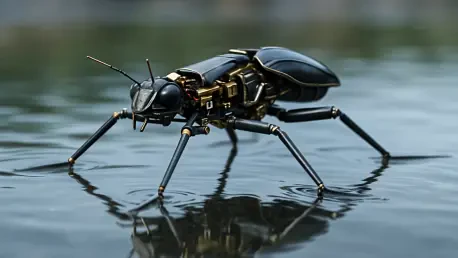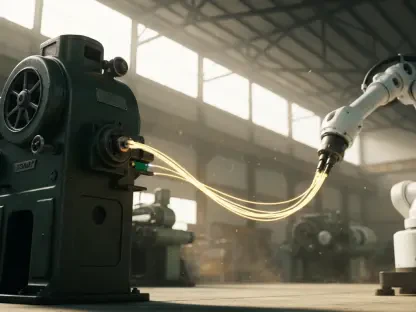Imagine a tiny insect, barely noticeable to the naked eye, gliding effortlessly across the surface of a turbulent stream, defying the chaos of rushing water with grace and precision. Water striders, particularly the Rhagovelia species often called ripple bugs, have captivated scientists for years with their ability to navigate aquatic environments in ways that seem almost supernatural. A groundbreaking study, born from a collaboration among researchers at the University of California, Berkeley, Georgia Institute of Technology, and Ajou University in South Korea, has now harnessed this natural marvel to create bioinspired robots. Published in Science, this research unveils the secrets behind the Rhagovelia’s unique fan-like feet and translates them into robotic designs that could redefine small-scale technology. The result, an innovative insect-scale robot known as the Rhagobot, showcases how nature’s ingenuity can inspire solutions for navigating complex water-air interfaces. This advancement not only deepens the understanding of biological locomotion but also opens exciting possibilities for applications in environmental monitoring and beyond, proving that some of the most profound innovations can stem from the smallest of creatures.
Decoding Nature’s Mastery of Movement
The Rhagovelia water strider stands apart from other members of its kind due to an extraordinary adaptation that allows it to thrive in the roughest of aquatic conditions. Unlike typical water striders from the Gerridae family, these insects possess specialized fan-like structures on their legs that enable them to achieve speeds of up to 120 body lengths per second. What makes this even more remarkable is the discovery that these fans operate passively, driven by surface tension and elastic forces rather than muscular effort. This means the fans can snap open and closed in a mere 10 milliseconds, facilitating rapid maneuvers without draining energy. High-speed imaging and detailed microscopic analysis revealed the flat-ribbon architecture of these structures, a design that balances flexibility for quick deployment with rigidity for powerful thrust. This unique combination addresses long-standing issues in small-scale aquatic locomotion, such as inefficient stroke recovery, offering a fresh perspective on how nature optimizes movement in challenging environments.
Further exploration into the Rhagovelia’s capabilities showed that these insects can execute sharp turns in just 50 milliseconds, a feat that rivals the agility of many flying creatures. The passive morphing of their fans eliminates the need for constant energy input, allowing sustained performance even in turbulent streams. This efficiency is a stark contrast to traditional assumptions that such rapid movements required active muscle control. The findings challenge previous understandings of aquatic insect biomechanics and provide a blueprint for energy-efficient systems that could be applied beyond biology. By studying these mechanisms, the research highlights how evolutionary adaptations over millions of years have refined solutions that human engineers are only beginning to grasp, setting the stage for innovative technological leaps inspired by such natural precision.
Building the Rhagobot: A Leap in Bioinspired Engineering
Translating the Rhagovelia water strider’s remarkable adaptations into a functional robotic system presented a formidable challenge, yet the development of the Rhagobot marks a significant achievement in bioinspired engineering. This insect-scale robot incorporates artificial self-morphing fans that replicate the natural design, using flexible materials that interact with water surface forces to mimic the bug’s efficiency. Weighing a mere milligram, these robotic fans embody a form of mechanical intelligence, deploying and collapsing without additional power, much like their biological counterparts. The creation process required overcoming substantial obstacles, particularly in replicating the intricate microstructure of the natural fans. Advanced techniques, such as scanning electron microscopy, provided critical insights into the flat-ribbon shape, ensuring the artificial design closely mirrored nature’s template. Tests with the Rhagobot demonstrated enhanced thrust, braking, and maneuverability, proving that bioinspired solutions can excel at navigating tricky water-air interfaces.
The implications of the Rhagobot extend far beyond academic curiosity, pointing to practical uses in real-world scenarios where small-scale robots must operate in dynamic conditions. Environmental monitoring, search-and-rescue operations, and exploration of aquatic environments are just a few areas where such technology could make a difference. The robot’s ability to handle complex maneuvers without heavy energy demands addresses a key limitation in conventional robotic designs, which often struggle with efficiency at smaller scales. This success underscores the potential of biomimicry as a guiding principle for engineering, showing how closely studying natural systems can yield innovations that outperform traditional approaches. The Rhagobot serves as a testament to the power of blending biology with technology, offering a glimpse into a future where robots move with the same finesse as the creatures that inspired them.
Collaboration as the Backbone of Innovation
The journey to create the Rhagobot and uncover the secrets of the Rhagovelia water strider relied heavily on a collaborative effort spanning multiple disciplines and institutions. Over several years, experts in experimental biology, fluid physics, and engineering design worked together to bridge the gap between observing a natural phenomenon and translating it into a tangible technological application. This interdisciplinary approach was vital in decoding the intricate mechanisms behind the insect’s locomotion, analyzing the physical forces at play, and crafting a robotic system that could emulate such efficiency. The synergy of diverse expertise debunked the outdated notion of solitary invention, highlighting how modern scientific breakthroughs often emerge from collective curiosity and shared skills. Each field brought unique strengths to the table, creating a comprehensive understanding that no single discipline could achieve alone.
Beyond the technical achievements, this collaboration serves as a model for future research in bioinspired technology. The integration of biological insights with engineering solutions required constant dialogue and adaptation among team members, ensuring that every aspect of the Rhagovelia’s design was accurately interpreted and applied. This teamwork not only resulted in the successful development of a bioinspired robot but also set a precedent for how complex challenges can be tackled through unified efforts. The project illustrates that advancements in robotics and beyond are increasingly dependent on such partnerships, where varied perspectives converge to solve problems that span multiple domains. As science continues to push boundaries, this collaborative spirit will remain essential in unlocking the full potential of nature’s lessons for technological progress.
Navigating Turbulence: Lessons for Real-World Applications
Rhagovelia water striders thrive in environments of intense turbulence, enduring disturbances far greater in relative terms than what humans experience during the most unsettling airplane rides. Their ability to maneuver through chaotic streams with precision offers invaluable insights for designing robots capable of operating in unpredictable settings. The Rhagobot, inspired by these insects, aims to replicate this resilience, targeting applications where stability and adaptability are paramount. Whether it’s monitoring environmental changes in remote water bodies or aiding in search-and-rescue missions across flooded areas, the potential for such technology is vast. By drawing from the insect’s capacity to handle extreme conditions, the research addresses a critical need in robotics for systems that can perform reliably when faced with instability, a common barrier in small-scale designs.
Delving deeper into the significance of this adaptability, the study emphasizes that turbulent environments pose unique challenges for both natural organisms and engineered systems. Traditional robotic designs often falter in such scenarios due to limitations in agility and energy efficiency, making the bioinspired approach a promising alternative. The Rhagobot’s design, rooted in the passive mechanisms of the Rhagovelia’s fans, provides a framework for creating machines that can navigate dynamic water-air interfaces without succumbing to the chaos. This focus on environmental resilience not only enhances the practical utility of small-scale robots but also broadens the scope of their deployment in real-world tasks. As technology evolves, emulating nature’s proven strategies for coping with disorder could become a cornerstone for developing tools that meet the demands of increasingly complex missions.
Future Horizons in Bioinspired Technology
Reflecting on the strides made through this research, it’s evident that the study of Rhagovelia water striders and the creation of the Rhagobot carved a significant path in bioinspired engineering. The discovery of passive, self-morphing fans that enabled unparalleled agility in turbulent waters provided a fresh lens on aquatic locomotion, while the robot’s development showcased how these natural principles could be practically applied. Collaborative efforts across biology, physics, and engineering played a crucial role in achieving these milestones, demonstrating the power of interdisciplinary work in unraveling complex challenges. Each finding, from the fans’ flat-ribbon structure to the Rhagobot’s enhanced maneuverability, contributed to a deeper appreciation of how evolution has honed solutions that technology can adapt.
Looking ahead, the next steps involve expanding on these insights to refine bioinspired designs for broader applications. Exploring whether the Rhagovelia’s mechanisms can support lift-based propulsion, akin to other aquatic species, could open new research avenues. Additionally, scaling the Rhagobot’s capabilities for diverse environments and tasks will be essential in realizing its potential for societal impact. Continued collaboration among scientists and engineers will drive these efforts, ensuring that future innovations build on the foundation laid by this study. As the field of biomimicry grows, integrating nature’s time-tested strategies into cutting-edge technology promises to yield tools that are not only efficient but also adaptable to the world’s most pressing needs.









